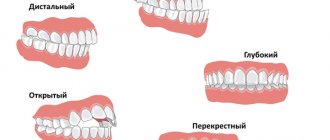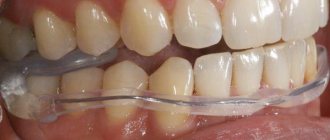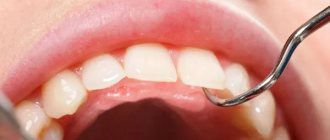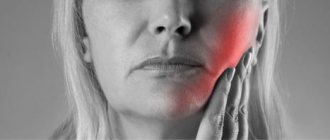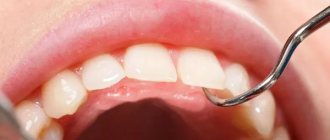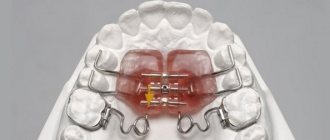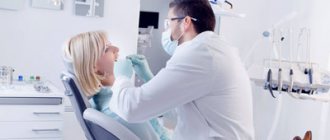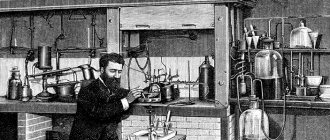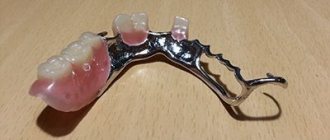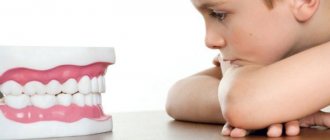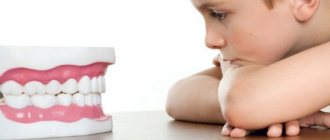4674
Bite correction during the period of changing primary teeth to permanent teeth occurs much easier and faster than moving row elements in adult patients.
For this reason, orthodontic treatment for children does not always require wearing visible and uncomfortable braces.
In most cases, the position of the teeth relative to the jaw line can be corrected using a removable structure - a plate equipped with a Bertoni screw.
General overview
The Bertoni screw is a fastening system that is an integral part of orthodontic leveling plates.
Made from plastic and metal alloy, which has excellent biocompatibility with natural tissues.
The thread and body of the element are made with maximum precision, and the surface of the rod is so smooth that the rotation of the thread and its sliding are very easy and do not cause additional inconvenience while wearing the device.
The design features of the screw completely eliminate its uncontrolled displacement. Main indications for use:
- change in the structure of the upper jaw row towards expansion. The best result can be achieved at the stage of formation of hard bone tissue, which occurs in childhood;
- for single or fragmentary movement of organs. The doctor sets the desired direction and distance within which the displacement must be achieved. These parameters determine the duration of the correction course.
Peculiarities
Plates with a Bertoni screw are selected individually, taking into account the anatomical features of the patient’s maxillofacial apparatus.
To obtain lasting positive dynamics, the device must be worn almost around the clock, removing it from the oral cavity only when necessary.
The fixation process occurs with the help of special hooks that are quite simply thrown over the teeth. This allows you to remove and put on the system yourself without the help of a specialist.
The principle of operation is to periodically tighten the screw mechanism, thus setting the required pressure force. As a rule, the doctor will do this the first time. Then, during the treatment process, the tension force of the metal arches is adjusted at home.
The Bertoni screw is the active part of the leveling structure. It has several independent guides, which makes it possible to adjust each sector independently. This allows you to stretch the teeth in the desired direction.
A special design advantage of the element is its three-dimensionality, which made it possible to combine two screws together - an expanding and an extending one. Thus, the plate itself has become significantly lighter and thinner.
What is the Brückle apparatus and the stages of its manufacture in the laboratory.
Let's talk here about the effectiveness of Ortho Snap aligners.
At this address https://www.vash-dentist.ru/ortodontiya/kapyi/nevidimyie-elayneryi-star-smile.html you will find reviews about Star Smile aligners.
How to tighten a dental plate?
The twisting procedure is necessary to increase the load, as well as expand the main surface of the plate, which is installed on the upper jaw. Your doctor will tell you how to tighten the dental plate and how often to do it. The process itself is not too complicated: using a key inserted into the main hole of the screw, one turn is made along the guide arrow on the tooth plate. After this, the child may feel discomfort for some time, but this procedure is necessary to achieve the desired result. In addition, if necessary, the plate can be returned to its previous position by turning back.
Dental plastic with a key for twisting
Types of plates
There are three types of orthodontic leveling mechanisms, each of which has individual indications for use:
- standard plates - used for minor bite defects when serious correction of the anomaly is not required. An ideal solution for giving the correct direction of growth to individual dental elements;
- with the addition of active components - they effectively align fragmented lesions and more complex occlusion pathologies. Such structures have a screw mechanism that regulates the tension force of the plates, which actively influence the direction of tooth growth;
- designs with a Bertoni screw - got their name in honor of their developer.
They make the system as efficient as possible. The main indication for use is correction of children's bite. The plate is less convenient in comparison with analog versions, but the results are several times superior to them.
The video describes in detail the types and principles of operation of the plates.
Device characteristics
The product consists of a plastic base, in the center of which there is a screw made of a medical metal alloy. There are arcs along the edges.
Localized parallel to the area of the lateral dental fragments, the arches create the load necessary for the therapeutic effect.
The device is made of medium-hard plastic. The color can be any. In this case, the shape of the plate repeats the palatal relief.
The arc is made of nickel or titanium alloy, and has the ability to “remember” the direction given to it. The thickness of the wire may vary.
The device is attached to special hooks made of the same material as the arcs.
In a number of models, activators are built into the plate, with the help of which the system is controlled. This is very convenient because one device is used throughout the entire correction period.
What does an orthodontic screw in plates look like and what is it for?
In general, an orthodontic screw or lock is a factory-made mechanical element that is included in many orthodontic plates. It is usually made from stainless steel.
There are different types of screws, different in size, shape, and purpose - some are used only in structures for the upper jaw (Bertoni, Steiner). Many of them are capable of working in several directions at once: moving individual teeth, symmetrically and asymmetrically expanding, narrowing or lengthening the base of the apparatus in order to influence the dentition.
Screws are made up of several threaded pins and have a thickening in the center called a barrel. There are holes in the drum - through them the plate is activated with a special key, which the orthodontist gives to the patient after installing the device.
Preparing the child
Alignment of teeth using this method is indicated at the stage of mixed dentition in a child. At a later age, this procedure is ineffective. Baby teeth are more amenable to correction of anomalies when the pressure force is not too high.
Despite the fact that the correction itself is not a particularly complex manipulation, at all stages of treatment the child should be under the periodic supervision of a dentist.
This requirement is due to the fact that the placement of the organs has not yet been fully formed and incorrect use of the device can cause harm to the teeth, including their complete loss.
The first place to start is visiting an orthodontist. The doctor will examine the oral cavity, evaluate the clinical picture and the degree of neglect of the anomaly, and prescribe an x-ray.
This analysis is a mandatory requirement. It provides more complete information about the condition of the jaw row, since only the crown part of the tooth is on the surface, and everything else is hidden from the eye of a specialist.
Based on the collected medical history, the doctor selects the type of device and gives parents detailed information about the principle of treatment, correct operation and measures for caring for the device.
At the preparatory stage , a treatment plan is developed, the approximate duration of the course, nuances are discussed - when the structure can be removed, how often to do it, how to help the baby quickly adapt to the presence of a foreign object in the mouth and minimize physical discomfort from its use.
Let's sum it up
Before tightening a dental plate for a child, you need to learn how to do it correctly. Immediately after installing the structure, the orthodontist independently activates the device and shows how to regularly adjust it. For this purpose, a special screw mechanism is provided, and the patient’s parents are given a key, which is inserted into the hole and scrolled the required number of times. How many revolutions and how often they need to be done depends on the individual schedule developed by the doctor.
Sometimes during twisting certain difficulties arise. If you take timely measures and go to the clinic, the damaged device can be restored without consequences for the treatment process.
Video on how to properly tighten a plate to straighten teeth:
Correction process
The treatment process begins with making an impression of the jaws. It is made from a wax mass. It is from this copy that the laboratory will form a plaster version of the removable braces.
The template will become the basis for the production of the plate , guaranteeing its maximum compliance with the anatomical features of the structure of the child’s jaws. It completely repeats the relief of the crown part of the tooth and gums.
During a follow-up visit to the doctor, the finished design is tried on, and if there are any discrepancies, adjustments are made. It takes no more than 10 minutes. The doctor shows how to independently change the tension force of the arc .
The specialist also determines the period until which the plate will be used, and with the onset of the first visible improvements, it will be clear what time frame the correction will be limited to.
The system is designed in such a way that a number of its active fragments can cause physical discomfort to a small patient, especially during the period of adaptation.
Sharp fragments rub the mucous membrane and can scratch the tongue. If your baby complains of pain, you should visit a doctor and have the device adjusted.
Since the plate is quite voluminous, adaptation to it occurs gradually. As a rule, the discomfort goes away after 15-20 days. Speech and chewing functions are completely restored.
How comfortable the rehabilitation will be largely depends on the behavior of the parents. Their attention, care and patience will help the child cope with the difficulties of adaptation.
Correction of bite defects using the T4A trainer and the principle of operation of the device.
This material contains detailed information about T4K trainers.
Follow the link https://www.vash-dentist.ru/ortodontiya/prikus/chto-lechit-vrach.html if you are interested in who a pediatric orthodontist is.
Main period
When the plate is selected, the doctor secures it in the patient’s mouth. Installation is carried out taking into account all possible nuances of wearing the plate.
The child must indicate in which places she rubs hard or does not hold. The number of turns of the key to accurately secure the plate in the mouth is calculated so that parents know how much the load on the jaw can be increased. The doctor must take into account all the uncomfortable moments in the process of fixing the plate.
Sharp corners, if any, must be adjusted to make the child comfortable. The design should not rub.
If inflammatory lesions appear during wearing, this means that it is not fastened correctly. Parents should monitor this moment. It is important to ask the child how he feels and listen carefully to his words.
Features of wearing plates with a Bertoni screw:
- The maximum effect is achieved only if the structure is worn around the clock.
- If there are minor anomalies, then wearing it can only be done during sleep.
- If the structure rubs the palate, gums or tongue, it is important to immediately see a doctor to have the plate adjusted.
- The child’s adaptation to wearing the plate takes an average of 2-3 weeks.
At first, the child may complain of discomfort, since the plate takes up a lot of space in the mouth. Its base is capable of covering the entire plane of the sky.
It can also temporarily make swallowing difficult and affect speech. Such changes are temporary, so within 2 weeks the small patient should get used to such design features.
In order for the wearing to be correct, parents must control all processes. It is important to keep an eye on the following points:
- how the child installs the plate;
- whether the screw is tightened correctly;
- whether the plate is removed before eating;
- whether the hygiene of the mouth and the entire system is carried out correctly.
Visits to the orthodontist should be regular. For the first 2-3 weeks, it is important to visit the doctor as soon as the child feels that the plate is rubbing or scratching.
For subsequent adjustments, it is important to visit the doctor at least once a month. On average, after six months the plate is changed, as the expansion zone has increased.
How the T4A trainer works and indications for its use.
This publication contains all the most important things about the T4k trainer.
Here https://zubovv.ru/ortodontiya/kapyi/invisalign-zamechatelnaya-sovremennaya-alternativa-nekrasivyim-skobam.html we will talk about Invisalign orthodontic aligners.
Deadlines for correcting defects
How long the treatment will last depends on many factors. Often, even a doctor cannot give such a prognosis at the initial stage.
Here everything depends on the degree of neglect of the anomaly, the hardness of the bone tissue, the age of the patient, and of course, compliance with all the orthodontist’s recommendations.
It is important for parents to understand that bite correction is a long process that requires patience and almost round-the-clock wearing of the plate.
On average, the course of treatment is 2 years, provided that the child uses the system at least 21 hours a day.
Rules of care
Plastic and metal alloy are the main components of the structure. Despite their strength, they can also break.
Moreover, the reason for this may be a banal failure to follow the rules for caring for the device.
For systems to last for a long time, it is necessary:
- Once a day, remove and clean the product with a soft toothbrush and toothpaste that does not contain abrasives;
- carry out weekly antiseptic treatment with formulations specially designed for this purpose;
- Before putting on the device each time, it must be rinsed well with warm boiled water;
- purchase a special container for storing records;
- regularly lubricate the Bertoni screw with oil - just a drop is enough to prevent stagnation of the rotating mechanism;
- do not use the structure while eating;
- avoid mechanical injuries in the jaw area , exclude sports activities associated with the risk of mechanical failure of the product for the entire course of treatment.
Price
The average cost of a leveling plate with a Bertoni screw is about 10,000 rubles. Depending on the place of purchase, this amount can vary between 10 - 15%.
Plates for individual elements are estimated at approximately 2,000 rubles.
At the same time, there are designs whose price is an order of magnitude more expensive - these are products of well-known brands and trademarks. The cost of the system can also be affected by the complexity of its manufacturing.
The course of correction is generally determined by the clinical picture of the pathology, the region of residence of the patient and the status of the clinic where treatment is carried out.
A visit to a specialist for advisory purposes will cost 500–700 rubles.
Reviews
Correction of childhood malocclusion pathologies using plates, in most clinical cases, is an ideal solution and, at the same time, the most popular option from the point of view of patients.
However, the final decision on the advisability of treatment using this device should only be made by a doctor.
If you are interested in the topic discussed in this article, you can leave your comment in the appropriate section.
If you find an error, please select a piece of text and press Ctrl+Enter.
Tags Bertoni screw bite correction plates for teeth straightening
Did you like the article? stay tuned
Previous article
Review of designs and assessment of the aesthetics of ceramic braces with photos
Next article
All the subtleties of using plastic braces to correct bite defects
Advantages of plate correction
If a specific clinical situation allows the possibility of using orthodontic plates to correct defects, then this has certain advantages:
- The devices can be removed for hygiene procedures. This allows you to minimize the risk of developing caries;
- caring for the records is simple and can be done by the child himself;
- devices allow you to solve orthodontic problems at an early age, when it is too early to install braces;
- the plates have affordable prices.
The network of dental clinics “Smile” offers bite treatment services for children using orthodontic plates. We guarantee reasonable prices, a family discount and the quality of correctional therapy at the level of international standards.
Our specialists have a high qualification status and constantly improve their professional level by studying in the best Russian and European dental centers.
Branches of our orthodontic center are located in Moscow within convenient transport and walking distance:
- branch near Alekseevskaya metro station (VDNKh district and Mira Ave.), address: st. 3rd Mytishchinskaya 3, building 2;
- branch in the Shelepikha metro area, address: Shelepikhinskaya embankment, 34, building 1.
We will correct your child's bite using a gentle method using plates. Make an appointment with an orthodontist and find out all the details from a specialist.
